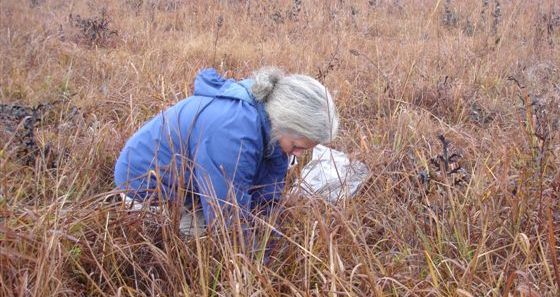 Shaw Nature Reserve horticulturist Diane Donovan collects seed at Baker Prairie near the Missouri/Arkansas border. Using plants of known local origin is one way to ensure that additions to your garden will thrive.
Shaw Nature Reserve horticulturist Diane Donovan collects seed at Baker Prairie near the Missouri/Arkansas border. Using plants of known local origin is one way to ensure that additions to your garden will thrive.
The Search for Landscape Plants in the Ozarks
by Scott Woodbury and Cindy Gilberg
Remote sink-holes, craggy bluffs, and soggy river bottoms may seem like unlikely places to find new plants for landscaping, but such places tend to put plants to the ultimate test. Scouring floods, summer drought, and erratic temperatures often generate tough plants that work well in the modern landscape.
Take, for instance, the Ozark alumroot (Heuchera villosa var. Ozarkana). In 2009, Shaw Nature Reserve horticulture staff collected seed of this species from wild populations in the southern Ozarks. Found on shaded bluffs growing out of rocky crevices, one can assume a high level of drought and shade tolerance. Since other Missouri species of alumroot are longlived, compact, and low-maintenance garden plants, there is a good chance that this species is as well. If the Ozark alumroot proves to be as gardenworthy as its close cousins prairie alumroot, American alumroot, and littleflower alumroot, then it will be given a prominent place in the Whitmire Wildflower Garden, and efforts will be made to produce and promote it for the public use.
Reserve horticulture staff have been searching for species new to horticulture for decades, mostly in eastern Missouri but more recently in the bootheel, southern Ozarks, and western Missouri. Last year’s trip set its sights on Southwest Missouri and Northwest Arkansas. With Theo Witsell (botanist for the Arkansas Natural Heritage Commission) as our guide, collection began at the Kings River Falls Natural Area near the 1921 Dripping Springs schoolhouse. A few of the species collected were Arkansas alumroot (Heuchera villosa var. arkansana), two viburnums (V. rafinesquianum and V. recognitum, Arkansas bedstraw (Galium arkansanum), marginal shield fern (Dryopteris marginalis), and umbrella magnolia (Magnolia tripetala). This is the most northerly population of umbrella magnolia in our region, and it may prove to be a hardy ecotype for St. Louis gardens.
Staff hiked to a wetland fen and collected several species of sedges (Carex spp.), rushes (Juncus spp.), and bushy aster (Aster dumosum), some of which may prove useful in rain gardening. At Baker Prairie, a rare remnant prairie close to the Arkansas/Missouri border, collections included heart-leaved Alexander (Zizia aptera), western rough goldenrod (Solidago radula), and whorled mountain mint (Pycnanthemum verticillatum var. pilosum). Other mountain mint species attract many species of butterflies, bees, and solitary wasps and are noteworthy garden plants. The 2009 trip ended at Hercules Glade, high in the Missouri Ozarks where the horticulture staff collected fringe tree (Chionanthus virginicus) and Missouri maiden-bush (Andrachne phyllanthoides). Missouri maiden-bush is a 3-foot-tall shrub with tiny leaves that resembles spirea. Plants like this may some day end up in garden centers and backyards throughout Missouri if they can earn their keep in the Whitmire Wildflower Garden first.
In 2009, 55 species new to the garden were collected, identified, processed for greenhouse production, and excess seed stored in a specially designed seed storage room that is part of the newly constructed facility at Shaw Nature Reserve. It is the new home for the Reserve’s horticulture, education, and maintenance departments and will house several Missouri Department of Conservation employees. The buildings were made possible in part through generous contributions from John and Connie McPheeters and Blanton and Peg Whitmire.
Authors’ note: Though some of the species mentioned are available in nurseries, few are of a known local origin. The best way to ensure that garden plants will thrive is to use plants of local origin (also called local ecotype). This is another important reason why seeds are collected from wild populations. It is also important to keep in mind that only small quantities of seed are collected from wild populations. Once sizeable populations are established in the Whitmire Wildflower Garden, plants are then produced in large quantities for public distribution. Remote sink-holes, craggy bluffs, and soggy river bottoms may seem like unlikely places to find new plants for landscaping, but such places tend to put plants to the ultimate test. Scouring floods, summer drought, and erratic temperatures often generate tough plants that work well in the modern landscape.
—Missouri Botanical Garden Bulletin Summer 2010